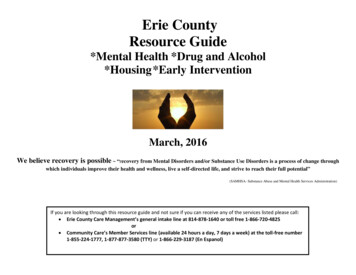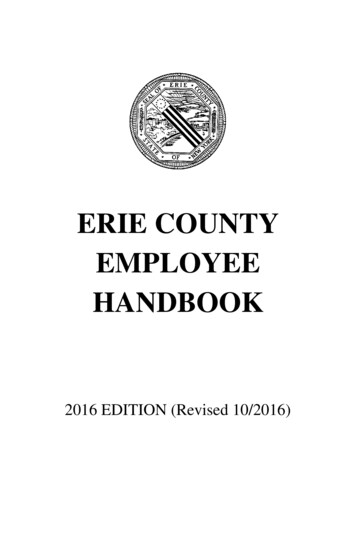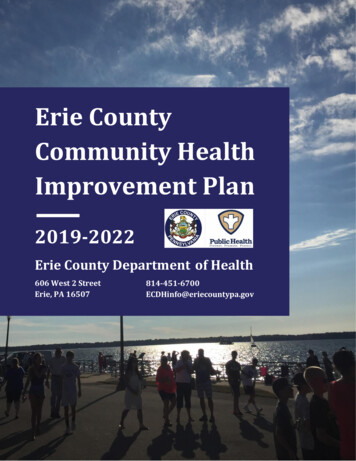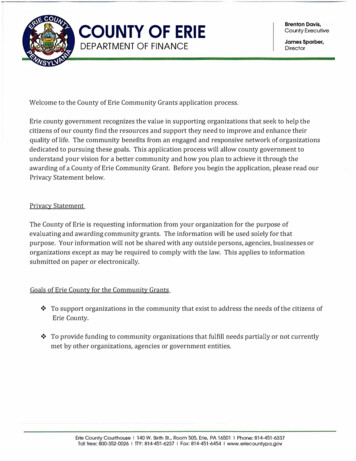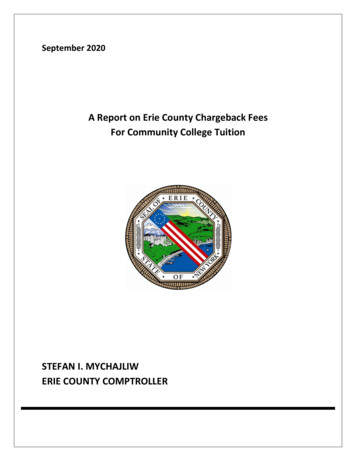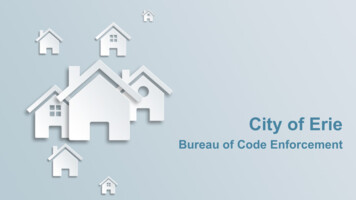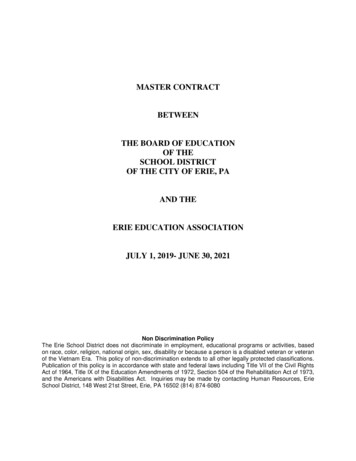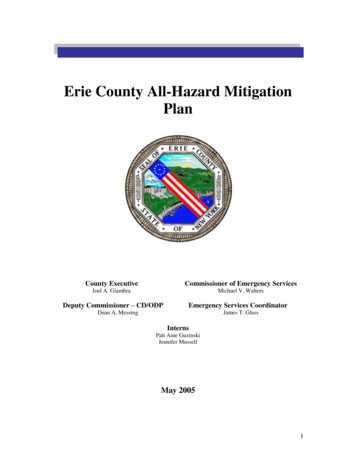
Transcription
Erie County All-Hazard MitigationPlanCounty ExecutiveCommissioner of Emergency ServicesJoel A. GiambraMichael V. WaltersDeputy Commissioner – CD/ODPEmergency Services CoordinatorDean A. MessingJames T. GlassInternsPati Aine GuzinskiJennifer MussellMay 20051
Table of ContentsSection1Executive SummaryIntroductionPurpose2Overview of Erie CountyGeographyWeatherLand UsePopulationEconomyEmergency Management3Planning ProcessDocumentation of Planning ProcessMulti-Jurisdictional Planning ParticipationMulti-Jurisdictional Plan Adoption4Risk AssessmentIdentifying Hazards: HAZNY and Erie County of ErieProfiling HazardsAssessing VulnerabilityIdentifying AssetsEstimating Potential Losses5Mitigation StrategyGeneral Mitigation PlanningIdentificationAnalysisImplementationFuture Hazard Mitigation StrategiesMitigation Strategies Utilizing GIS2
6Plan MaintenanceContinued Public InvolvementImplementation through Existing Programs7Supporting Maps and DocumentsMap of Erie CountyDetailed Map of City of BuffaloDetailed Map of City of LackawannaDetailed Map of City of TonawandaChemical FacilitiesFire CompaniesCritical FacilitiesMajor Commercial AreasSheltersDetailed Topography with FloodplainsTransportation Routes in Erie CountyErie and Niagara Counties and the Niagara Region ofCanadaHistorical SitesAll-Hazard Mitigation MapWaterwaysWater BodiesMinesWellsWest Nile Positives – 2002Lyme Disease Incidence – 2002Distribution of Ixodes Scapularis TicksClimate Outlook8AnnexSeasonal Transportation ProgramComprehensive Floodplain Management PlanHazardous Materials Response AnnexRadiological Response Protection AddendumCross Border Contingency PlanEmergency Alert System Plan9Information Sources/Bibliography3
1 Executive SummaryIntroductionThe Erie County All-Hazard Mitigation Plan represents the county’s approach tomitigating natural, technological, and human caused disasters which may result infederal disaster declarations within the county’s borders. Section 322, MitigationPlanning of the Robert T. Stafford Disaster Relief and Emergency Assistance Act,enacted by Section 104 of the Disaster Mitigation Act of 2000 (DMA) providesnew emphasis on mitigation planning. Section 322 discusses the need for localgovernments to closely coordinate mitigation planning and implementation withstate efforts as a condition of disaster assistance.This plan is not intended to serve as a reference for immediate disaster response.This plan focuses on actions that can be implemented prior to disaster events inorder to reduce potential loss of life and damage to property. It is also intended toassist the county in identifying and prioritizing mitigation opportunitiesimmediately occurring after a major disaster.The scope of this plan is to identify the hazards which have historically resulted infederally declared disasters and to develop policies, programs, and strategies tomitigate the effects of those disasters. Hazards that have the potential to causesignificant impact, even though they have not previously resulted in disasterdeclarations, are also addressed. It should be noted that while Section 322emphasizes natural disasters, the county continues to address potential hazards inthree categories: natural, technological and human induced.There is a separate appendix section which includes additional documents, reportsand plans. For security reasons, human caused hazards are addressed briefly in thebody of this plan. Further information will be found in a separate annex.PurposeThis plan has been developed with the assistance of every municipality in ErieCounty (see below for listing), the BOCES system and the public to meet newfederal legislation requirements. All jurisdictions in Erie County have participatedin the completion of this plan and thus all jurisdictions are represented in thisdocument. The two Indian tribes in Erie County are not directly participating butare covered by the municipality which they are a part of (Cattaraugus Indianreservation is covered under Brant and the Tonawanda Indian Reservation is4
covered under Newstead). This legislation stipulates that each community in theUnited States have an All Hazard Mitigation Plan by November 2004.This plan will enable each municipality, including school districts, to be eligiblefor funding if a federal disaster is declared and funds are disseminated. The planalso allows for application of mitigation grants to lessen or prevent futuredamages.This plan will be kept up to date on a periodic basis by a committee representedby municipal leaders, disaster coordinators, the public, civic organizations, andled by representatives of the Erie County Department of Emergency Services.In future sections of this plan you will find references to many different plans.The All-Hazard Mitigation Plan incorporates the Seasonal Transportation Plan,the Comprehensive Floodplain Management Plan, the Emergency Alert SystemPlan, the Comprehensive Emergency Management Plan, its Annexes, andAddendums, and due to the shared international border, the Cross BorderContingency Plan. These documents will help in the implementation of this AllHazard Mitigation Plan and have been included in a separate referenced section.5
2 Overview of Erie CountyGeographyErie County is approximately 1247 square miles, which includes 25 towns, 16villages, and 3 cities. The county is bounded by Lake Erie and Canada to the west,Niagara County to the north, Genesee and Wyoming County to the east, andCattaraugus and Chautauqua Counties to the south.WeatherThe climate of Erie County is temperate. The average summer temperature rangeis 60 - 78ºF punctuated by a few days of high humidity. The average wintertemperature range is 20 to 35ºF. Winds in Western New York are moderate,punctuated by occasional gusts due to passing cold fronts or thunderstorms. Thetopography and location of the county does not contribute to frequent tornadoes.Land UseThe land use pattern that has existed for decades has led to the expansion ofsuburban towns and a mixed pattern of stability, decline, and re-development inthe City of Buffalo. The northern towns of Erie County have experienced thegreatest growth and the eastern towns are beginning to experience developmentpressures while the southern towns are developing at a slower pace.PopulationThe Census Bureau from 1990 lists Erie County population at 968,532 withvarious different ethnic groups represented. It is estimated that 35,532 peopleliving in the county have a mobility limitation. This number excludes personsliving in care facilities. This population is considered by emergency managerswhen formulating evacuation plans. The Census Bureau estimates that 111,485persons in the county identify themselves as non-English speakers or as havingtrouble speaking English. This population is also considered by emergencyresponders.EconomyIn the early 1900’s, Erie County was the largest grain port in the entire country.Erie County also had a large steel making industry which included largecompanies such as, Republic Steel, Bethlehem Steel, and Gibraltar Steel. AfterBethlehem and Republic Steel closed, the area became financially depressed.Now Erie County is growing with a service oriented job market. Erie County isnow a major New York industrial and commercial center. The following tablesillustrate the major components of employment in the Buffalo-Niagara FallsMetropolitan Area.6
Components of Erie County’s ance, Insurance, Real EstateServicesGovernmentConstruction and Mining%15.204.7124.265.5730.5215.444.30Source: NYS Department of Labor – July 1998 DataEmergency ManagementThere are 26 Public Service Answering Points (PSAP’s) to which Police, Fire,Emergency Medical Services and other emergency personnel are received ordispatched. There are 94 volunteer and 3 paid fire departments in Erie County.The 3 paid departments are located in the 3 cities of Erie County; Buffalo,Tonawanda, and Lackawanna. The 94 volunteer fire departments are categorizedby fire companies, fire departments, fire districts, or fire protection districts. ErieCounty also has 5 hazardous materials emergency response teams which respondto nearby counties in times of mutual aid.Erie County has a very pro-active emergency management program that has wonmany awards and grants and is well known for the various different plans createdto address any potential emergency. In 1986, the Erie County Legislature createdthe department of Emergency Services, which consists of Fire, DisasterPreparedness, and Emergency Medical Services. Each division has a DeputyCommissioner for its supervision which reports to the Commissioner. Throughoutthe county there are both private and volunteer ambulance squads which areinvolved with different fire departments.7
3 Planning ProcessDocumentation of Planning ProcessTwo members of the Erie County Department of Emergency Services wereinitially involved in the PDMG application process. They were:Dean A Messing – Deputy Commissioner of Emergency Services, DisasterPreparedness Division and Erie County’s Mitigation CoordinatorJames T. Glass – Emergency Services CoordinatorThis team submitted the original grant application after learning that othercounties and municipalities had submitted grant applications when the originalrequests were publicized. The original application was submitted after allavailable funds were allocated to other counties and municipalities. Funds becameavailable to Erie County when left over and over allocated funds were released.The team then spoke to NYSEMO representatives and made arrangements to havea pre-grant program overview conducted by Rad Anderson, Mary Ann Basile andKerry Maloney from the mitigation branch.The Planning Committee was formed as a result of meetings held with SEMO.The committee is comprised of the following members:Mike Walters – Erie County Department of Emergency Services,CommissionerDean Messing – Erie County Department of Emergency Services, CivilDefense/Disaster Preparedness Deputy CommissionerJames Glass - Erie County Department of Emergency Services, EmergencyServices CoordinatorPatrick Daley - Erie County Department of Emergency Services, AssistantCoordinator of Haz Mat PlanningJennifer Mussell - Erie County Department of Emergency Services, InternPati Aine Guzinski - Erie County Department of Emergency Services, InternDale Morris – Erie County Department of Environment and Planning – GISSupervisorMichael Gangemi – Erie County Department of Environment and Planning GIS Mapping CoordinatorCharles Alessi – Erie County Department of Sewage Management – DeputyCommissionerJudy Levan – National Weather Service/Buffalo – Meteorologist8
Spencer Schofield – Erie County Environment and Planning – SeniorPlannerMr. Timothy Balunis – United States Coast Guard – Port SecurityConsultantMr. Gary Shofstal – United States Army Corps of Engineers – EmergencyManagement CoordinatorThe Planning Committee worked together with the Disaster PreparednessAdvisory Board and the local municipalities Disaster Coordinators to completethe All Hazard Plan (see listing on pages 11 - 13) as discussed below. ThePlanning Committee was mostly involved with compiling the informationreceived from municipalities and other contributors as well as reviewing draftsand the final submission of the All Hazard Plan. The larger Planning Groupconsisted of the Local Disaster Coordinators and The Disaster PreparednessAdvisory Board as well as the public and other sources discussed below. Therewere many meetings held in order to get the initial plan submitted, the seconddraft submitted and to get this hopefully final draft submitted for acceptance byFEMA. Here is a schedule of the different meetings and review sessions whichled up to the completion of this plan.Some of the other organizations that were involved with the planning process andthe gathering and supplying of information are as follows:New York State Emergency Management Office –Region V Director and SEMO Mitigation BranchErie County Local Emergency Planning CommitteeWestern New York Contingency Planning GroupInternational Joint Committee on Emergency PlanningNiagara County Emergency ManagementNiagara Regional Emergency Services (Niagara Region of Canada)Verizon TelephoneNiagara Mohawk Power GridNiagara Frontier Transportation AuthorityNew York State Electric and GasMultidisciplinary Center for Earthquake Engineering Research (MCEER)Some of the plans utilized, but not necessarily all listed below, which you willfind in this document, are as follows:Erie County Comprehensive Emergency Management PlanHazardous Materials Response AnnexDomestic Preparedness AddendumRadiological Protection Addendum9
Emergency Alert SystemEvacuation AnnexComprehensive Floodplain Management PlanDebris Management PlanAnimal Care AnnexCross Border Contingency PlanSeasonal Transportation PlanSevere Storm Emergency Plan – Village of SpringvilleTown of Amherst Flood Mitigation Plan ReportHARRP – 2000 (Hazard Awareness and Risk Reduction Programfor the Millennium 2000) – Flood Damage Reduction MeasuresMulti-Jurisdictional Planning ParticipationEach disaster coordinator participated in one (or more than one) of several ways.Municipalities that had not yet conducted a HAZNY survey of their communitywere encouraged to do so. This process continues, with the goal of having all 44municipalities conduct a HAZNY survey.The coordinators who have not yet conducted a HAZNY survey were asked tocompile a list of hazards in their communities. These lists were compiled usinghistorical records, reviewing existing plans and reports, talking to experts ingovernment, academia and the private sector. The various websites listed inlibrary at the end of Understanding Your Risks, Identifying Hazards andEstimating Losses FEMA 386-2 (2001) were also utilized. All of the worksheetsfrom this publication were reproduced for the disaster coordinators to utilize. Aneducational session explaining the county All Hazard Mitigation Plan and how toutilize the sheets was conducted.Individual municipality plans were also reviewed while writing this plan. It is tobe noted that the intent of the county All Hazard Mitigation Plan is not to preempt any individual community plan, but to enhance it. The individualmunicipality plans were general plans from each municipality regarding thehistory of the area, the commercial activities, information about local governmentand past hazards. These plans were used to provide the All Hazard Plan with thebackground information specific to each municipality. The individual plans werealso used to list hazards pertinent to that municipality.Local municipality disaster plans were also used which listed more specificallythe hazards deemed important to each municipality. Past hazard occurrences werelisted as well as damage amounts. The Erie County Comprehensive EmergencyManagement Plan (pg 69) was used extensively for identification of countywidehazards and mitigation strategies which will be discussed later.As a result of this process several communities have developed or enhanced theircommunities’ disaster response/mitigation committee. They are experiencinggreater participation on various community levels.10
Public participation was encouraged in a variety of ways. The public was openlyinvited to all local HAZNY meetings to discuss any concerns. Articles solicitingcommunity input were placed in local newspapers and our office number waslisted. Staff from the Erie County Department of Emergency Services attendedcommunity meetings to explain the concept of mitigation planning and theimportance of public participation and public input was solicited. The DisasterPreparedness Advisory Board meetings were open to the public and there are alsocommon citizens on the Board. At every meeting, the public was asked for input,but comments were not collected or reported. Even with all of these methods toinvolve the public very little information was actually received. At most of theindividual municipality HAZNY’s the public were represented and helped toanswer the questions regarding the rankings of hazards.The Seneca Nation was invited to participate in the development of this plan. AFEMA representative worked with Nation members to explain and begin themitigation planning process. The Seneca Nation conducted their own HAZNYsurvey and attended the surveys of surrounding municipalities. We will continueto work with, involve and support the Seneca Nation in their mitigation efforts.There are a number of alliances involving neighboring jurisdictions. There is the 8County Health Department Coalition which works together in the StrategicNational Stockpile and the Vaccination Program. There are also HazardousMaterials Team mutual aid agreements between Erie County and neighboringjurisdictions. There is also HAZWEST which involves 13 counties in WesternNew York that deals with HAZMAT response. There is the International JointCommittee on Emergency Planning which includes Erie County, Niagara County,and the Niagara Region of Canada. These alliances were considered in draftingthe All Hazard Mitigation Plan for planning and mitigation purposes. A copy ofthis plan was given to Sean Bertleff Emergency Coordinator of the Niagara regionof Canada and James Volkosh Emergency Coordinator of Niagara County so thattheir input could be added to the plan. At the time of this writing we have notreceived any information from either of them.Mitigation strategies for the county’s two biggest natural hazards, flood andsevere winter storms, are included in the respective plans for these hazards whichcan be found in the Annex. Since mitigation planning is not static, the planningprocess will continue for all of these plans. Regular Disaster Coordinatormeetings will address this process as necessary.11
Local Disaster CoordinatorsFIRSTNAMEBBorchertMr. DavidMr. DanMr. RobertMr. TerryMr. JamesMr. DennisMs. ArleneMr. NickMr. CharlesMr. RichardMr. WilliamMr. GeorgeMr. WilliamMr. MarkMr. ShaunMr. CharlesMr. PatMs. SharonMr. MichaelMr. BillMr. ScottMr. EarlMr. RobertMr. PeterChief TomMs. JeanMr. CarlMr. MichaelMr. DennisMr. EdwardMr. TonyMr. JamesMr. RobertMr. GeraldMr. DonaldMr. MichaelMr. MikeMr. MichaelMr. JamesLASTNAMEBissonetteBorchertBraggCaber, ltersWillibeyZogariaZymanekLOCATIONT. ClarenceV. AkronT. WalesV. FarnhamV. AngolaT. TonawandaT. AldenV. GowandaT. EvansV. HamburgT. BostonT. MarillaT./V. Orchard ParkT. Aurora/V. E. AuroraT. SardiniaV. KenmoreT. HollandC. LackawannaT. West SenecaV. BlasdellV. LancasterT. Cheektowaga/V. SloanT. LancasterT. Grand IslandC. TonawandaV. SpringvilleT./V. North CollinsV. AldenT. ColdenT. ElmaC. BuffaloT. HamburgT. EdenT. NewsteadT. CollinsT. BrantT. ConcordV. DepewT. Amherst/V. Wmsv.The role of the local Disaster Coordinators was to identify hazards specific toeach community. Other tasks assigned were to: assess vulnerability, identifyassets, estimate potential losses, analyze development trends, create mitigationgoals and define the strategies to achieve these goals.12
Disaster Preparedness Advisory BoardDPABFIRSTNAME LASTNAMEAGENCYMr. ThomasAurelioErie Co. LegislatureMr. TimothyBalunisDOHS USCGFr. JosephBayneThe Franciscan CenterDr. AnthonyBillittierEC Health Dept.Ms. LyndaBureyEnv. Health & SafetyMr. JimConnorsErie Co. Water AuthorityMr. MarkCotterVA WNY Health Care SystemMr. PatrickDaleyECODPSgt. MichaelDebrowNew York State PoliceMr. KeithDillinghamFire Advisory BoardMr. StephenFreeLatter Day SaintsMr. JamesGambinoAmericorps/Red CrossChief EdwardGehenT. West Seneca PDMr. JamesGlassEC Emergency ServicesCdr. Paul M.GuggUSCG MSOMr. DonHarderVerizonMr. Louis B.HenryMJW CorporationDiv. Chief Jack HessBuffalo Fire Dept.Mr. RickHetrickSalvation ArmyMr. NealHodgsonErie Co. MEMr. TimothyHopkinsNYSDOTMr. RonaldJacobsCitizen MemberMr. MichaelKerlWest Seneca Dis.Coord.Ms. JoanKesnerNYS Senator StachowskiMr. PaulKlocE/N Funeral DirectorsDet. JamesKochHamburg PD/ALERTMr. GeneKremzierARES/RACESCaptain James LaMacchiaBuffalo Fire DepartmentMs. MariaLehmanEC DPWMs. JudithLevanNtl. Weather ServiceMr. EarlLoderCheektowaga ODPMs. ChristaLombardoBuffalo Fire Dept.Mr. ErnestMatthewsEC FC Mutual Aid Org.Mr. JamesMcSweenyNational Fuel GasCol. Gregory L. MioduckiNYS MilitaryMr. MichaelMuscarellaCity of BuffaloMs. LucyMysiakES ConsultantMr. LeonNadlerE.C. Health Dept.Mr. WilliamPikeWNY Health Care Assoc.Mr. WilliamRansom IIINYS Electric & GasMr. TerryReinkeNFTAMr. RandallRiderEC FD Officers Assoc.Mr. BrettRiderEC Vol. Firemen's Assoc.Mr. LarryRubinEC DEPMr. MiguelSantosNiagara MohawkMr. Roy M.ScheiflaRetired – Niagara MohawkMr. JohnSharkeyVA WNY Health CareMr. JeffreyShawM&T Trust Company13
DPABFIRSTNAME LASTNAMEAGENCYMr. GaryShoffstallArmy Corps of Eng.Chief BobStastoBuffalo Fire DepartmentMr. KennethSwainNYSDOTMr. KenTurnerAmerican Red CrossMr. PeterTutuskaEC Social ServicesMr. MichaelWaltersECDESMr. George N. WhiteNYS Thruway AuthorityMr. JamesAmherst Dis. Coord.ZymanekThe primary role of The Disaster Preparedness Advisory group is to provide inputbased upon their individual areas of expertise. This group includesrepresentatives from various community organizations including, but not limitedto, business, religious, academic, not-for-profit, government and private citizens.Monthly meetings were conducted with the Disaster Preparedness AdvisoryBoard, the Local Disaster Coordinators and the Planning Committee to discuss theAll Hazard Plan. These meetings brought together the larger Planning Group forthis plan. At these meetings information was discussed from each municipality aswell as on the county level to understand information that was pertinent toinvolving in the All Hazard Plan. We also had many guest speakers at ourmeetings which we involved in the planning process such as, Buffalo ComputerGraphics, University of Buffalo, BOCES, and other representatives listed aboveinvolved with the DPAB. The broader planning team consisted of a very broadrange of knowledge, expertise, and interests. The Planning Committee onlycompiled, organized and reviewed the All Hazard Plan.In review, each municipality was required to provide hazard informationregarding their area as well as any mitigation strategies currently in use orstrategies that are soon to be implemented. Monetary loss information was alsocollected for hazards to help each municipality understand what the largestproblems were. This information was collected with the help of many others ineach municipality as previously mentioned. Multi-jurisdictional planning waslargely accomplished through monthly meetings with the Disaster Coordinators ofeach municipality. During the course of these meetings, the informationuncovered within each municipality was discussed. Neighboring municipalitiesdiscussed mutual aid efforts and other mitigation strategies. Ideas were exchangedregarding the All-Hazard Plan’s development such as the format and whatinformation from each municipality should be provided.Multi-Jurisdictional Plan AdoptionIn 2003, all 44 municipalities formally adopted a resolution accepting the ErieCounty All Hazard Mitigation Plan for completion in November 2004.14
The changes and revisions to the Erie County All Hazard Mitigation Plan willcontinue to be presented at each meeting of the Disaster Coordinators andDisaster Advisory Boards.Due to the lengthy process of obtaining resolutions from each municipality andthe short time frame for plan development, the current resolutions will stand.Municipalities have stated that when the final draft is approved, resolutions willbe re-submitted for final, formal approval.15
4 Risk AssessmentIdentifying Hazards: HAZNY and Erie CountyThe latest HAZNY survey for Erie County was conducted in 2003. The results ofthis survey identified the following hazards in descending order:HazardTerrorismHazmat (In Transit)Hazmat (Fixed Site)ExplosionTransportation AccidentWinter Storm (Severe)FireIce StormSevere StormEpidemicOil SpillTornadoCivil UnrestRadiological (Fixed Site)Structural CollapseFloodIce JamEarthquakeUtility FailureAir ContaminationWater Supply ContaminationRadiological (In Transit)Mine CollapseTsunami/Wave ActionExtreme TemperaturesWildfireDroughtFuel ShortageFood ShortageInfestationDam 12812216
HAZNY is an automated, interactive spreadsheet that asks specific questions onpotential hazards in a community and records and evaluates the responses to thesequestions. HAZNY also includes historical and expert data on selected hazards.The participants in the Erie County HAZNY workshop were from variousorganizations representing a wide variety of county, federal and municipalgovernment, private business, public utilities, academic institutions, private andpublic health care and non-government organizations (sign-in sheet availableupon request).There are several factors utilized by the HAZNY program in determining hazardvulnerability.The first factor is scope. This factor looks at two aspects of scope: (1) What areaor areas in each jurisdiction could be impacted by the hazard and (2) what are thechances of the hazard triggering another hazard causing a cascade effect?When assessing impact, participants are asked to assume a credible worst casehazard event. The choices are: a single location, several individual locations,throughout a small region or throughout a large region.When assessing cascade effects, participants were again asked to assume acredible worst case hazard event. The choices are: no, highly unlikely, yes, somepotential and yes, highly likely.The second factor was frequency. In this program frequency is a prediction ofhow often a hazard will occur in the future. In this instance, the program is notlooking for the frequency of the credible worst case event, but occurrences thatrequire activation of the jurisdiction’s emergency response forces beyond normalday-to-day operations, including mutual aid plans.The frequency choices are: a rare event (less than once every 50 years), aninfrequent event (between once every 8 years and once every 50 years, inclusive),a regular event (occurs between once a year and once every 7 years, inclusive)and a frequent event (occurs more than once a year).History is a good indicator of future events and was reviewed when makingselections. We also reviewed past hazard reports, media reports and articles andspecialized reports such as a completion of severe weather events authorized bythe National Weather Service. Town historians and senior citizens also providedinput.17
The next factor is impact. As with the other factors, it is based on a credibleworst case event. The analysis looks individually at people, private property andpublic facilities (infrastructure).Impact on people is concerned with the hazard’s ability to seriously injure or killpeople. A serious injury is defined as an injury that requires the victim toreceived immediate medical attention to preserve life and/or limb.The categories allow each jurisdiction to define “large numbers” as appropriate totheir response capacity. The categories are as follows:Serious injury or death is likely, but not in large numbersSerious injury or death is likely in large numbers (local EMS is“maxed out”)Serious injury or death is likely in extremely large numbers(substantial outside assistance is required)Impact on private property looks at physical or economic damage to privateproperty including structures, homes, businesses, belongings and income. Thechoices include little or no damage, moderate damage and severe damages. Thedamage incurred from a disaster is quantified on a “macro level”.Damage to the community infrastructure is concerned specifically with structuraldamage, including key government buildings, roads, bridges, sewer and water andpower lines. The choices include little or no structural damage, moderatestructural damage and severe structural damage. Once again, the damage incurredis quantified on a “macro level”.Factor four is onset. This factor is an inquiry into warning time. It poses thequestion: “How much time is there between the initial recognition of anapproaching hazard and when the hazard begins to impact the community?” Forthe time of onset analysis, a credible worst case scenario is the basis. The choicesare: no warning, several hours warning, several hours warning, one day warning,up to one week warning.Factor five is duration. Two questions are addressed in this section: (1) how longdoes the hazard remain active and (2) how long do emergency operationscontinue? Again, both answers are based on a credible worst case scenario.Hazard duration measures only the actual time the hazard is active. The choicesare: less than one day, one day, two to three days, four days to a week and morethan one week.Long term impacts are measured in incident stabilization time. This is measuredby determining how long emergency operations for the jurisdiction continue oncethe hazard is inactive. The hazard is considered stabilized when the emergency18
operations return to normal. Long term clean up efforts and environmentalremediation do not count as part of the incident stabilization time. Disastercoordinators were encouraged to include clean up and remediation when planningfor potential future events.Included in this report is the 2003 HAZNY Report for Erie County.The Disaster Advisory Board reviewed the results of the risk assessment at ameeting held on March 26, 2003 to begin discussion of mitigation strategies.Each disaster coordinator was asked to schedule a HAZNY survey for theirmunicipality. At this date, 40 of the 44 surveys have been completed. T
Erie and Niagara Counties and the Niagara Region of Canada Historical Sites All-Hazard Mitigation Map Waterways Water Bodies Mines Wells West Nile Positives - 2002 Lyme Disease Incidence - 2002 Distribution of Ixodes Scapularis Ticks Climate Outlook 8 Annex Seasonal Transportation Program Comprehensive Floodplain Management Plan
